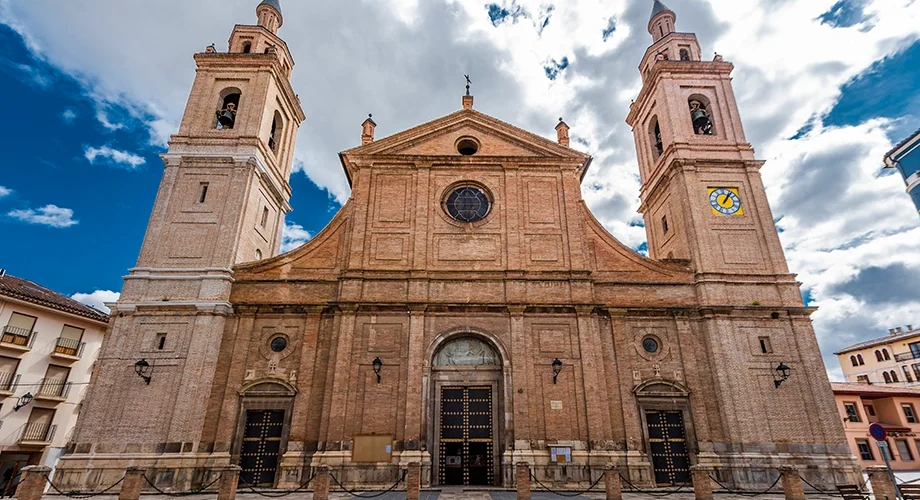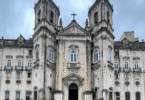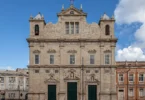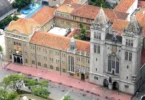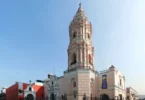Introduction
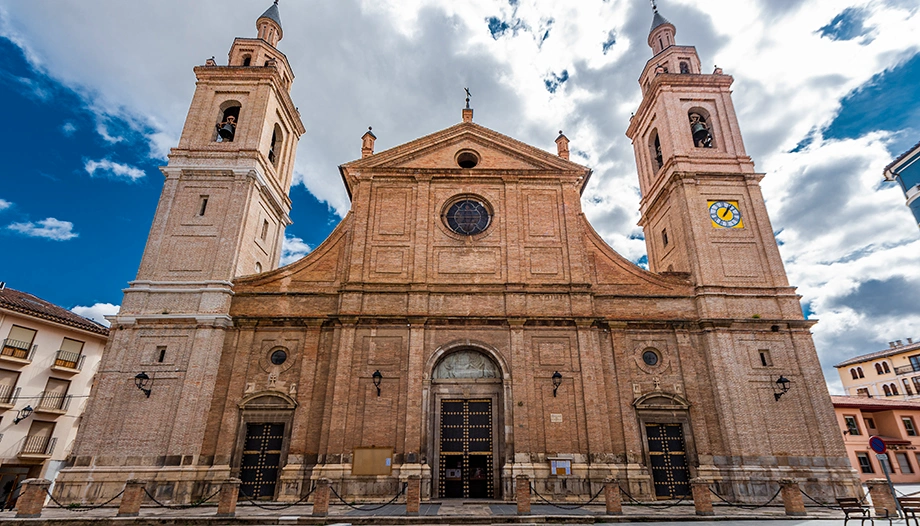
The Royal Basilica-Collegiate Church of the Holy Sepulchre is a prominent 17th-century Catholic parish church situated in the historic town of Calatayud, in the province of Zaragoza, Spain. It forms part of the Archpriesthood of Calatayud within the Diocese of Tarazona and holds great religious and architectural significance. This church serves as the principal temple of the Equestrian Order of the Holy Sepulchre of Jerusalem in Spain, making it the spiritual and administrative center or parent house of the Order within the country. Architecturally, the church is notable for its striking façade, which features three grand entrance doors and is flanked by two imposing towers, creating a symmetrical and majestic frontage. One of its most remarkable interior features is a richly adorned tabernacle, underscoring the church’s liturgical importance. The entire structure is designed as a faithful replica of the Church of the Holy Sepulchre in Jerusalem, reflecting the deep symbolic and devotional ties between the Spanish church and the sacred Christian site in the Holy Land. As a historical and religious landmark, the Royal Basilica-Collegiate Church of the Holy Sepulchre not only serves as a center of worship but also stands as a testament to Spain’s enduring connection with the Holy Sepulchre tradition and the Catholic heritage of the region.
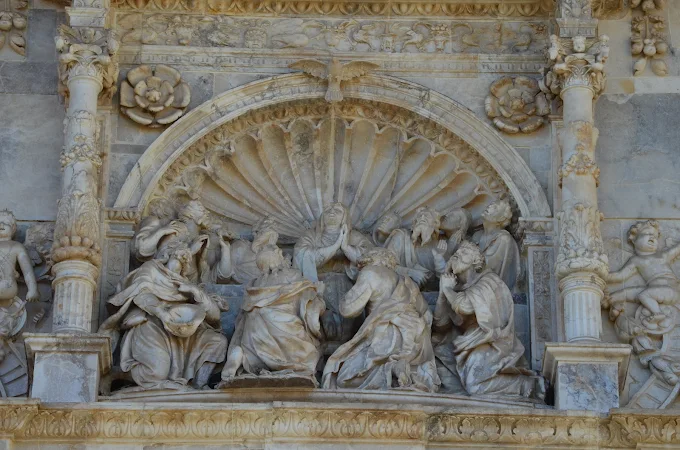
Origins and Royal Legacy
The origins of the Basilica of the Holy Sepulchre in Calatayud are rooted in the early 12th century, during the reign of King Alfonso I of Aragon, known as “the Battler.” After the Christian reconquest of Calatayud from Muslim control in 1120 following the decisive Battle of Cutanda the city became part of the Crown of Aragon. In a bold and unconventional move, King Alfonso drafted a testament in 1131 bequeathing his entire kingdom to three military-religious orders based in Jerusalem: the Canons of the Holy Sepulchre, the Knights Templar, and the Hospitallers. This decision shocked the Aragonese nobility, who deemed it politically untenable. Consequently, they disregarded the will and appointed Alfonso’s brother, Ramiro II formerly a Benedictine monk as king. To ensure political stability, Ramiro II arranged the betrothal of his infant daughter, Petronila, to Ramon Berenguer IV, Count of Barcelona, thereby uniting the Kingdom of Aragon with the County of Barcelona. Although the religious orders were denied control over the kingdom, a legal and diplomatic compromise was reached. In 1146, Ramon Berenguer IV granted the Order of the Holy Sepulchre several properties as compensation, the most prominent being Calatayud. This marked the beginning of the Order’s long-standing presence in the city.
First Constructions and Medieval Expansion
The Order of the Holy Sepulchre quickly established its presence in Calatayud. In 1156, the first Collegiate Church was constructed on a site adjacent to the city’s medieval walls. Designed as a monastic complex, it included a church, a cloister, and residential quarters for the canons, who followed the Rule of Saint Augustine. This Romanesque church served both liturgical and communal purposes. In 1249, the church underwent significant enlargement and was solemnly consecrated. As the influence and resources of the Order grew, so did its architectural ambitions. By the 14th century, a decision was made to replace the Romanesque structure with a new church built in the Mudéjar style, reflecting the unique fusion of Islamic and Christian design that characterized Aragonese architecture. While most of the original Romanesque elements were lost during this reconstruction, a few archaeological remnants have been preserved. During this period, the Order’s relationship with the Crown of Aragon remained strong. In 1489, when Pope Innocent VIII attempted to merge the Order of the Holy Sepulchre with the Order of Malta, Ferdinand the Catholic intervened. Thanks to his influence, Pope Leo X allowed the Calatayud Priory to maintain its independence, preserving the Order’s unique identity in Spain.
Architectural Flourishing in the 17th Century
The 17th century marked a period of architectural transformation and artistic enrichment. Under the leadership of Prior Juan de Palafox, a new church was commissioned in 1605 to replace the decaying Mudéjar structure. The project was entrusted to architect Gaspar de Villaverde, who drew inspiration from Renaissance ideals and the Church of the Gesù in Rome a model for Counter-Reformation ecclesiastical architecture. Completed in 1613, the new basilica featured a Latin cross layout with three naves, a prominent transept, a semicircular apse, and a grand dome topped with a lantern. The main façade, flanked by twin towers, presented a sober and symmetrical appearance with geometric ornamentation. Inside, the basilica was richly adorned with eight side altarpieces that formed a narrative cycle of Christ’s Passion, beginning with Palm Sunday and ending with the Descent from the Cross. These works, created by artists such as Francisco del Condado, Juan de Velasco, and José de Campos, were funded by various priors and canons. The choir, constructed in 1640 by Pedro Virto and Bernardino Vililla, added an element of solemn grandeur. Its semicircular stalls were decorated with reliefs, including a notable image of Saint Augustine, symbolizing the Order’s spiritual lineage.
Baroque Enhancements in the 18th Century
In the 18th century, the church was further embellished in the Baroque style, aligning it with contemporary artistic trends. Decorative wrought-iron railings were added to the side chapels, enhancing the separation and focus of each sacred space. A monumental gate, installed in 1789, created a formal threshold into the main sanctuary. One of the most striking additions was the baldachin or canopy erected in 1772 over the Holy Sepulchre sculpture. Designed with theatrical flair, it exemplified the grandeur of Italian Baroque, likely influenced by architect Martín de Aldehuela and executed by Félix Malo of Calatayud. The presbytery was also redesigned, incorporating twin pipe organs and extensive marble decoration to highlight the liturgical focus of the sanctuary. These enhancements made the church not only a place of worship but also a visually powerful space that embodied the glory and solemnity of the Catholic faith during the Counter-Reformation era.
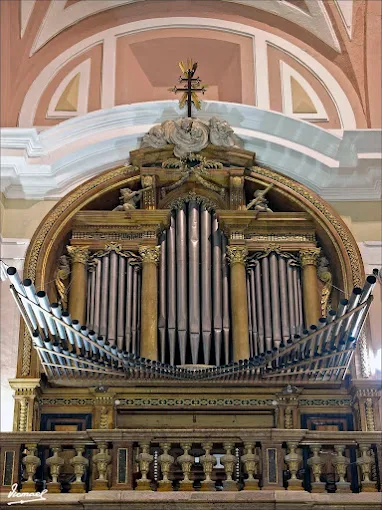
Destruction and Suppression in the 19th Century
The 19th century brought significant hardship to the church and its community. During the Peninsular War, French forces invaded Calatayud in 1808 and looted the basilica. Much of its valuable heritage goldwork, liturgical textiles, historical archives, and even the organs was destroyed or repurposed for war. The organ pipes, for instance, were melted down for ammunition. Worse still was the impact of the Mendizábal Confiscations in 1854, a liberal policy that targeted ecclesiastical property. The Collegiate Church of the Holy Sepulchre, which had long been exempt from diocesan control and answered directly to the Holy See and the Patriarchate of Jerusalem, was formally suppressed. Its last prior, Don Manuel Rodrigo de Villabriga, was exiled to Málaga, and the church was downgraded to a regular parish within the Diocese of Tarazona, ending centuries of autonomy.
Revival and Restoration in the 20th Century
Efforts to restore the church’s status began in 1900, led by parish priest Don Mariano García. With the support of Bishop Juan Soldevila y Palacio, the Holy See issued the Brief Sancta Templa Dei in 1901, restoring the title of Collegiate Church ad honorem. Though the canons were now secular priests, the church’s historical dignity was preserved. The parish priest was henceforth also named prior. Throughout the 20th century, various restoration projects were carried out. A new organ was installed in 1903, the chapter house was restored, and maintenance of the structure was prioritized. Following the Second Vatican Council, liturgical reforms were introduced under Prior Jacinto Alcoitia (1969–1997). The church’s pastoral role expanded, especially after a 1984 reorganization made it one of the largest parishes in the diocese. Importantly, the spiritual link with the Order of the Holy Sepulchre was revived. Knights and ladies of the Order were again welcomed as honorary canons, and annual joint chapters were hosted in Calatayud. Under Prior Miguel González (1997–2018), extensive beautification projects were undertaken, including repainting the naves and dome, and renovating priestly living quarters in the priory palace.
Elevation to Basilica in the 21st Century
In 2020, Calatayud celebrated the 900th anniversary of its reconquest. Recognizing the historic and artistic significance of the church, Bishop Eusebio Hernández Sola formally petitioned the Vatican to elevate the temple to the rank of Pontifical Basilica. In preparation, major renovations were undertaken. The unused neo-Romanesque baptismal font was restored and installed in the Chapel of the Pietà, a new sacrament chapel was established in the Chapel of Carmen, and the presbytery was enhanced with a marble ambo and seating. On February 23, 2020, the church and its altar were solemnly rededicated, and Don Javier-Vicente Sanz was sworn in as the new prior. Despite delays due to the COVID-19 pandemic, the Holy See officially granted the title of Basilica on November 9, 2020. The public proclamation and the investiture of Prior Sanz as an ecclesiastical knight took place on June 12, 2021, in accordance with the Order’s traditions.
Legacy and Mission Today
With a legacy spanning almost nine centuries, the Basilica of the Holy Sepulchre in Calatayud is more than a monument it is a living testimony to Christian faith, resilience, and cultural identity. As the mother church of the Order of the Holy Sepulchre in Spain, it continues to inspire devotion and historical awareness. Its architecture, liturgy, and community reflect centuries of change, challenge, and continuity. Today, the basilica remains a dynamic spiritual and cultural center, committed to preserving its sacred heritage while embracing its pastoral mission. It stands as both a historical symbol and a living church an enduring witness to faith across the ages.
Architecture of Basilica-Collegiate Church of the Holy Sepulchre, Calatayud, Spain
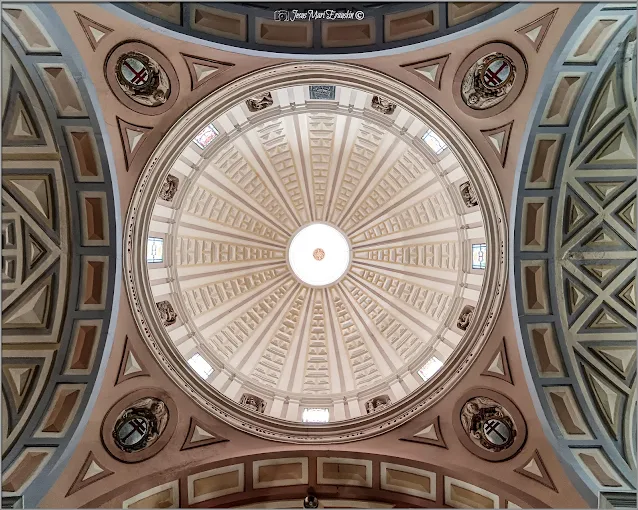
Architectural Heritage and Location
The Royal Basilica-Collegiate Church of the Holy Sepulchre holds the prestigious designation of a Site of Cultural Interest within Aragon’s heritage. It is strategically located next to the historic Somajas Gate, now known as Zaragoza Gate, marking its importance in the urban fabric of Calatayud. The current basilica was completed in 1613 by the architect Gaspar de Villaverde, who designed the building as a proto-Baroque temple following the Herrerian architectural tradition. This structure was built over a former Mudejar-style church, traces of which still survive, preserving a vital link to the site’s medieval past.
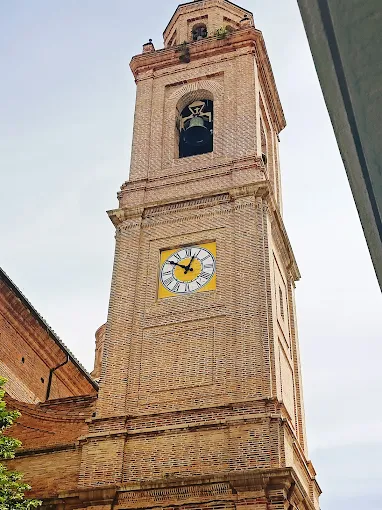
Exterior Design and Materials
The exterior of the basilica is primarily composed of brickwork, with only the base and the doorways crafted from ashlar stone. The façade exhibits a simple yet dignified design, characterized by geometric square and rectangular panels created by raised bricks. Flanking the façade are two imposing towers, each divided into three square levels and crowned with an octagonal section topped by a conical spire. This arrangement creates a balanced and harmonious silhouette that stands out in the cityscape.
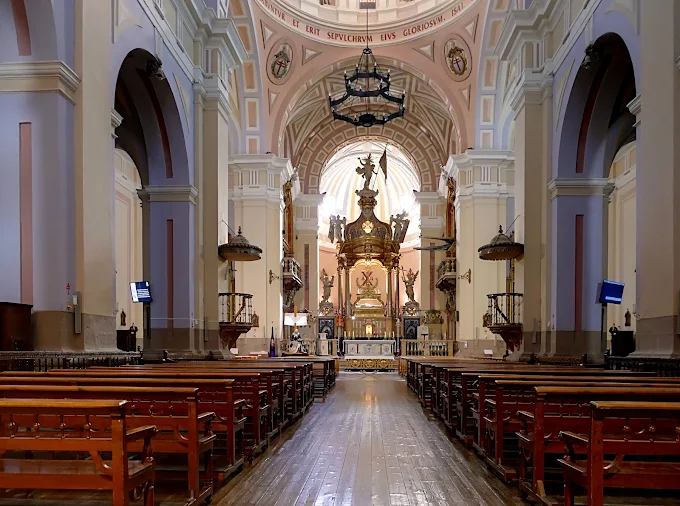
Interior Design and Structure
Inside, the church boasts a monumental spatial arrangement with three naves—central and two side aisles. The central nave is notably wider, drawing the eye forward toward the altar. The transept does not project significantly beyond the sides of the church, giving the floor plan a more elongated rectangular shape. The presbytery area is notably deep, allowing ample space to accommodate the choir. Separating the naves are Tuscan-style pillars, which support semicircular arches that lend structural strength while maintaining an open, airy feel. The vaulting above each nave varies: the central nave is crowned with a lunette vault that allows light and space, while the side naves have groin vaults that efficiently distribute weight. A large dome rises above the transept, supported by pendentives that transition from the square base to the circular dome. The dome’s drum includes eight windows, each framed by niches housing sculptures of angels bearing symbols of Christ’s Passion. The lantern atop the dome adds further illumination and a vertical focal point.
Artistic Decoration: Altarpieces
The basilica’s interior is richly decorated with altarpieces that represent the 17th-century school of Calatayud artists, including sculptors, gilders, and painters. These altarpieces narrate the entire cycle of the Passion of Christ, offering a detailed catechesis through art. There are eight such altarpieces lining the side aisles six commissioned by the prior Juan de Palafox and two by Canon Don Francisco Yago de Soria, created in 1666. They are unified stylistically and contribute to the church’s overall artistic coherence.
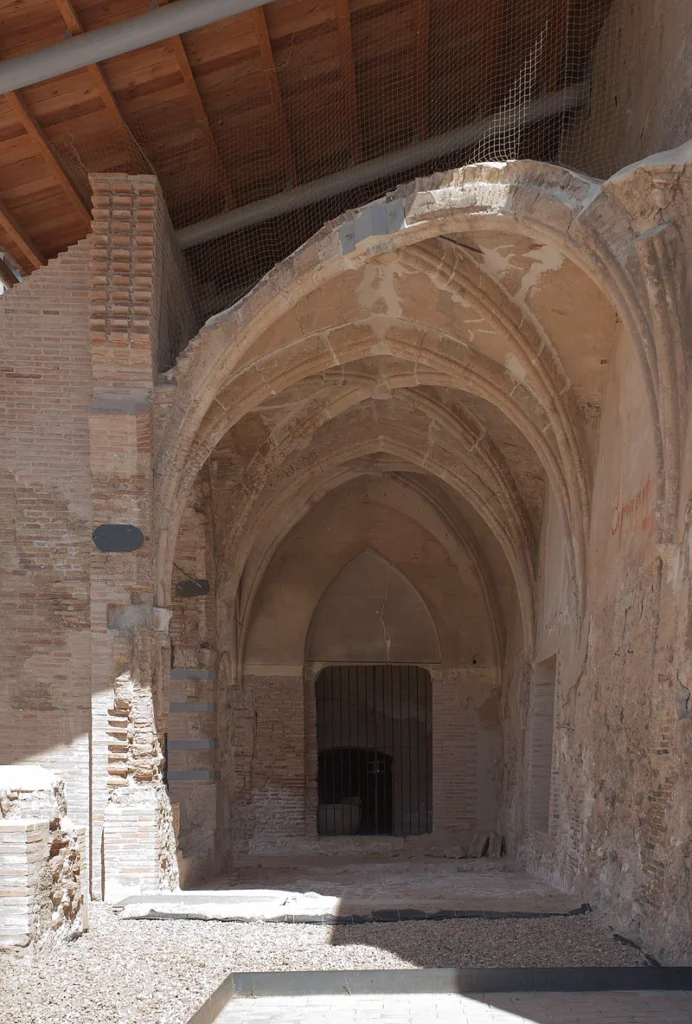
The Cloister: History and Architecture
The cloister is one of the most historically significant remnants of the earlier Mudejar construction under the jurisdiction of the Commandery of the Order of the Holy Sepulchre of Jerusalem, documented in Calatayud since the mid-12th century. Built in the mid-14th century, the cloister originally featured a square plan, but today only about half of it remains due to its ruinous condition. Each bay of the cloister is divided into five sections with simple ribbed vaulting. These vaults open onto the central courtyard through three large pointed arches, which remain unadorned. The arches are separated by rectangular buttresses, and while many sections are now partitioned, the part attached to the convent preserves remnants of decorative stitch work. Above the ground floor is a second story characterized by pointed arches three for every lower bay and crowned by projecting brick eaves that add architectural interest. In the 16th century, a third floor was added featuring semicircular openings with parapets containing oculi, although most of these have since been bricked up. The cloister of Calatayud may have served as a prototype for cloisters of the Order in other cities, highlighting its architectural and historical importance.
Feast Day
Feast Day : Second Sunday after Easter.
The Basilica-Collegiate Church of the Holy Sepulchre in Calatayud, Spain celebrates its major feast day on the Second Sunday after Easter. This celebration is known as the Feast of the Holy Sepulchre and was reinstated as the principal solemnity of the Collegiate by the Spanish Knights of the Order of the Holy Sepulchre.
Church Mass Timing
Monday to Saturday : 07:30 PM
Sunday : 09:00 AM, 12:00 PM, 01:00 PM, 06:30 PM
Church Opening Time:
Monday to Saturday : 9:30 AM – 1:00 PM, 6:00 PM – 8:00 PM
Sunday : 8:45 PM – 1:45 PM, 6:00 PM – 7:30 PM
Contact Info
Address : Basilica-Collegiate Church of the Holy Sepulchre
C.Sepulcro Alta, 1, 50300 Calatayud, Zaragoza, Spain.
Phone : +34 976 88 40 90
Accommodations
Connectivities
Airway
Basilica-Collegiate Church of the Holy Sepulchre, Calatayud, Spain, to Zaragoza Airport (ZAZ), distance 50 min (76.8 km) via A-2.
Railway
Basilica-Collegiate Church of the Holy Sepulchre, Calatayud, Spain, to Estación de tren de Calatayud 50300 Calatayud, distance between 6 min (1.7 km) via P.º Sixto Celorrio.

